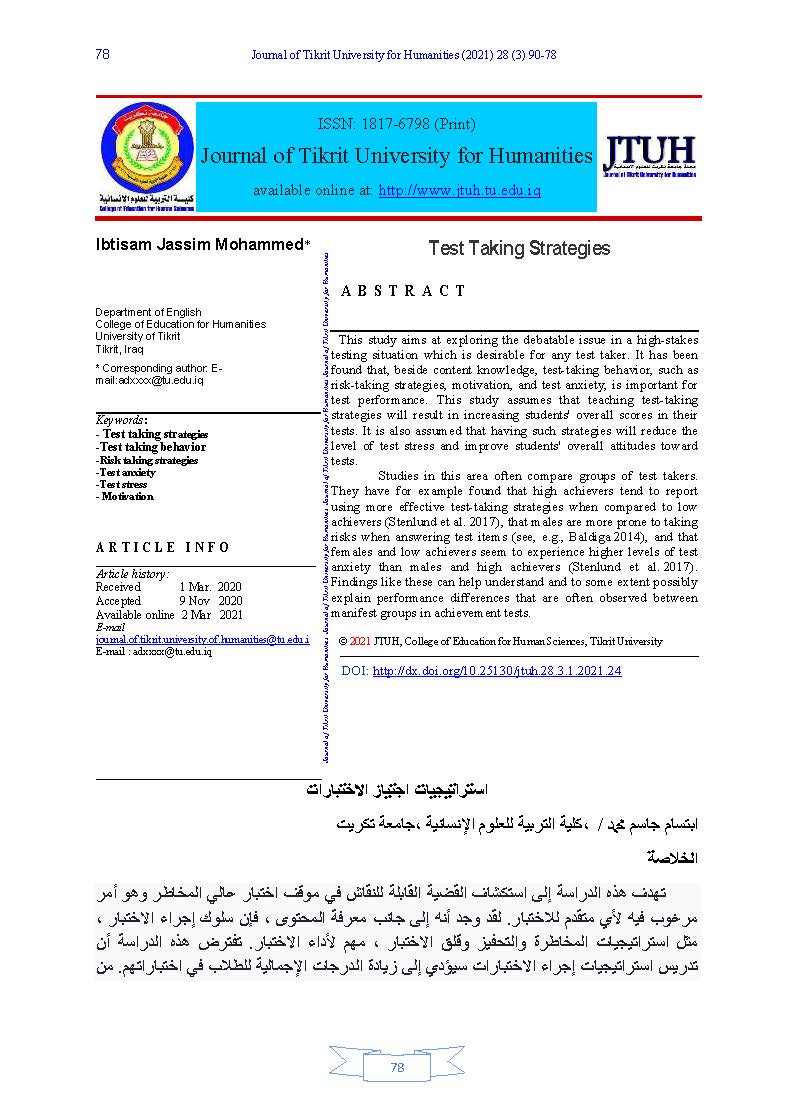استراتيجيات اجتياز الاختبارات
محتوى المقالة الرئيسي
الملخص
تهدف هذه الدراسة إلى استكشاف القضية القابلة للنقاش في موقف اختبار عالي المخاطر وهو أمر مرغوب فيه لأي متقدم للاختبار. لقد وجد أنه إلى جانب معرفة المحتوى ، فإن سلوك إجراء الاختبار ، مثل استراتيجيات المخاطرة والتحفيز وقلق الاختبار ، مهم لأداء الاختبار. تفترض هذه الدراسة أن تدريس استراتيجيات إجراء الاختبارات سيؤدي إلى زيادة الدرجات الإجمالية للطلاب في اختباراتهم. من المفترض أيضًا أن وجود مثل هذه الاستراتيجيات سيقلل من مستوى إجهاد الاختبار ويحسن المواقف العامة للطلاب تجاه الاختبارات.غالبًا ما تقارن الدراسات في هذا المجال بين مجموعات المتقدمين للاختبار. لقد وجدوا على سبيل المثال أن المتفوقين يميلون إلى استخدام استراتيجيات أكثر فاعلية في إجراء الاختبارات بالمقارنة مع ذوي التحصيل المنخفض (Stenlund et al. 2017) ، أن الذكور أكثر عرضة للمخاطرة عند الإجابة على عناصر الاختبار (انظر ، على سبيل المثال ، Baldiga 2014) ، وأن الإناث وذوي التحصيل المنخفض يبدو أنهم يعانون من مستويات أعلى من قلق الاختبار مقارنة بالذكور والمتفوقين (Stenlund et al. 2017). يمكن أن تساعد مثل هذه النتائج في فهم اختلافات الأداء التي يتم ملاحظتها غالبًا بين المجموعات بشكل واضح في اختبارات الإنجاز وربما تفسرها إلى حد ما.
المقاييس
تفاصيل المقالة

هذا العمل مرخص بموجب Creative Commons Attribution 4.0 International License.
College of Education for Humanities, TIKRIT UNIVERSITY. THIS IS AN OPEN ACCESS ARTICLE UNDER THE CC BY LICENSE http://creativecommons.org/licenses/by/4.0/
المراجع
Al Fraidan, A., & Al-Khalaf, K. (2012). Test-taking strategies of Arab EFL learners on multiple choice tests. International Education Studies, 5(4), 80-85.
Baldiga, K. (2014). Gender differences in willingness to guess. Manag Sci, 60(2), 434–448.
Bicak, B. (2013). Scale for test preparation and test taking strategies. Educational Science: Theory and Practice, 13(1), 279–289.
Bremmer, S. (1999). Language learning strategies and language proficiency: investigating the relationship in Hong Kong. The Canadian Modern Language Review, 55, 496-514.
Brodsky, M. (2004). Preparing for tests. Retrieved from www.mth.msu.edu/mccarthy/student.information/testprep.html
Casbarro, J. (2005). Test anxiety & what you can do about it. In A Practical Guide for Teachers, Parents, and Kids. U.S.A: National Professional Resources.
Chargar, E. (2002). Test anxiety. Retrieved from http:// www.umr.edu/~cousel/test.
Cohen, A. D. (2000). Strategies in Language and Using a Second Language. Beijing: Foreign Language Teaching and Research Press.
Cohen, A. D., & Upton, T. A. (2006). Strategies in responding to the new TOEFL reading tasks (ETS Research Report No. RR-06-06). Princeton, N.J: Educational Testing Service.
Coombe, C., & N. Hubley. (1988). Empowering students in test-taking strategies. Paper presented at TESOL Arabia Conference, Alin, UAE.
Deanna, L. N. (2002). Language learning strategies and English proficiency of Chinese University students. Regent University: Unpublished Ph.D. dissertation.
Dodeen, H. M., Abdelfattah, F., & Alshumrani, S. (2014). Test-taking skills of secondary students: The relationship with motivation, attitudes, anxiety and attitudes towards tests. South African Journal of Education, 34(2), 1–18.
Fieber, S. (2001). Test anxiety. Retrieved from http:// www. Counseling.uci.
Jimenez, R. T., Garcia, G. E., & Pearson, D. P. (1996). The reading strategies of bilingual Latin students who are successful English readers: opportunities and obstacles. Reading Research Quarterly, 31, 90-112
Krivoshik, L. (2003). Taking Essays Tests. Retrieved from
Lane, P. (2001, August 31). How to take tests? A three-step approach. Khaleej Times Weekend, p.6.
Liu, O. (2004). Investigating the relationship between test preparation and TOEFL iBT performance. Retrieved from Educational Testing Service: http://onlinelibrary.wiley.com/doi/10.1002/ets2.12016/epdf
Loulou, D. (1995). Making the A: How to study for tests. ERIC / AE Digest Series. Retrieved from http://www.campus.cua.edu/www/eric_ae/digests/tm9510.htm
Milnamow, K. (2001). Relieving Test Anxiety. Retrieved from
Peng, Y. 2005. Test preparation strategies and test taking strategies use in Chinese high school students (Unpublished doctoral dissertation), University of Nevada, Las Vegas, USA.
Phakiti, A. (2003). A closer look at the relationship of cognitive and metacognitive strategy use to EFL reading achievement test performance. Language Testing, 20(1), 26-56.
Stenlund, T., Eklöf, H., & Lyrén, P.-E. (2017). Group differences in test-taking behavior: An example from a high-stakes testing program. Assessment in Education: Principles, Policy & Practice, 24(1), 4–20. doi: 10.1080/0969594X.2016.1142935.
Sweetnam, K.R. (2002). Test taking strategies and student achievement. Cloquet, Minnesota, USA: Running Head.
VanZile-Tamsen, C., & Livingston, J. A. (1999). The differential impact of motivation on the self-regulated strategy use of high- and low-achieving college students. Journal of College Student Development, 40, 54–60. www.uic.edu/depts/counseletr/ace/testanxiety.htm
Winke, P., & Lim, H. (2017). The effects of test preparation on second-language listening test performance. Language Assessment Quarterly, 14, 380–397. doi:10.1080/15434303.2017.1399396
Young, C. (2003). Preparing for Tests. Retrieved from http: www.sunynassau.edu/dptpages/ashs/lab/Study.html




